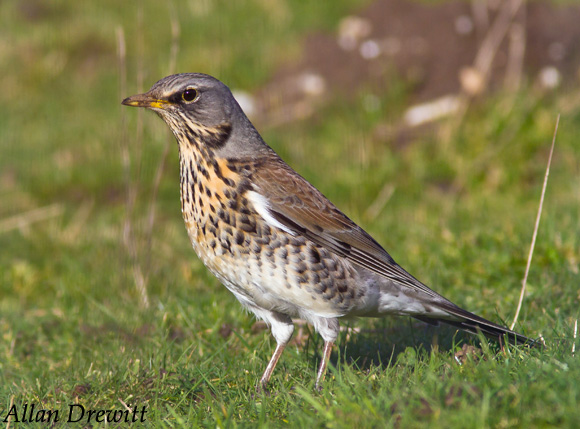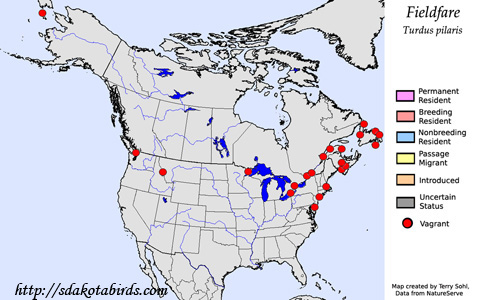| Length: 10 inches | Wingspan: 15 inches | Seasonality: Non-resident in South Dakota |
| ID Keys: Gray head, brown back, orange-buffy wash on breast, spotted breast and flanks | ||
 The
Fieldfare is a Eurasian thrush species that is very similar in overall
structure to the American Robin.
They are named after the Anglo-Saxon word "fieldware" which translates as
"traveller of the fields". They breed in central Europe and
Scandanavia, eastward through Asia. They are vagrants in North
America, but have been found a number of times, in a variety of locations.
The majority of North American sightings are in eastern Canada and the
northeastern U.S. However, they have also been found a handful of
times in Alaska, and more rarely, in the interior of the continent.
One was once found in Minnesota, and another in Montana.
The
Fieldfare is a Eurasian thrush species that is very similar in overall
structure to the American Robin.
They are named after the Anglo-Saxon word "fieldware" which translates as
"traveller of the fields". They breed in central Europe and
Scandanavia, eastward through Asia. They are vagrants in North
America, but have been found a number of times, in a variety of locations.
The majority of North American sightings are in eastern Canada and the
northeastern U.S. However, they have also been found a handful of
times in Alaska, and more rarely, in the interior of the continent.
One was once found in Minnesota, and another in Montana.
Habitat: Found in a variety of open and semi-open habitats, including open woodlands, hedgerows, park land, suburban gardens, and other areas that offer open foraging space along with scattered cover.
Diet: During the summer breeding season, they feed heavily on earthworms, snails, insects, and other small invertebrates. Outside of the breeding season, fruits and berries may make up most of the diet.
Behavior: Fieldfares are often very gregarious, particularly outside of the breeding season. They may form relatively large foraging flocks in migration and winter, often joining other birds such as other thrushes and starlings. Foraging is primarily done by hopping along the ground pausing periodically as they search for food.
Nesting: The nest of a Fieldfare is a cup, constructed of grasses, twigs, moss, and other vegetative material, often bound together by mud. The female lays between 4 and 6 eggs, and she alone incubates them. The eggs hatch after about 2 weeks, and both parents help feed and raise the young.
Song: The song of a Fieldfare is a series of whistled phrases and kack notes.
Migration: Considered migratory in most of their range, but some often do stay near breeding locations for the entire year. In Europe, most Scandanavian birds stay for the winter, but some move southward and westward. In the United Kingdom, they are only very rare breeders, but may be present in good numbers in winter. They are rather nomadic and unpredictable at times, staying in one location as long as adequate foraging is present (such as berries). Once berries and other food sources become depleted, they're likely to move on to a new location.
Interactive eBird map: Click here to access an interactive eBird map of Fieldfare sightings
Similar Species: In North America, it's most likely to be confused with American Robin. The spotted, pale underparts distinguish it from the Robin, but young American Robins have spots and may look relatively similar to a Fieldfare.
Conservation Status: Populations of Fieldfare are found over a very wide geographic area, they are common in parts of their range, and overall numbers appear to be generally stable. The IUCN lists the Fieldfare as a species of "Least Concern".
Further Information: 1) WhatBird - Fieldfare
2) Royal Society for the Protection of Birds - Fieldfare
3) BirdLife International - Fieldfare
Photo Information: Photo by Allan Drewitt - Photo licensed under Creative Commons Attribution NonCommercial NoDerivs 2.0 Generic License
| Click below for a higher-resolution map |
 |
| South Dakota Status: Non-resident in South Dakota |
Additional Fieldfare Photos (coming soon!!)
